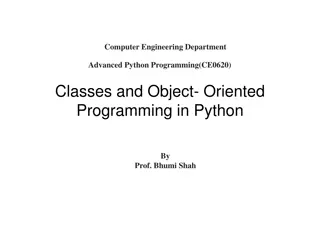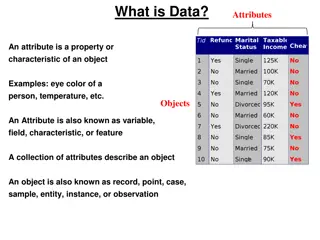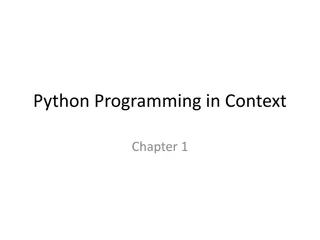Object Attributes and Methods in Python
Explore the inheritance of built-in object attributes in Python, including methods like __str__ and __repr__. Learn how these methods are used for object representation and string conversion. Discover how to customize these methods in your own classes for human-readable output.
Download Presentation

Please find below an Image/Link to download the presentation.
The content on the website is provided AS IS for your information and personal use only. It may not be sold, licensed, or shared on other websites without obtaining consent from the author.If you encounter any issues during the download, it is possible that the publisher has removed the file from their server.
You are allowed to download the files provided on this website for personal or commercial use, subject to the condition that they are used lawfully. All files are the property of their respective owners.
The content on the website is provided AS IS for your information and personal use only. It may not be sold, licensed, or shared on other websites without obtaining consent from the author.
E N D
Presentation Transcript
Dunder Functions & Random Numbers
It's all objects All the built-in types inherit from object:
Built-in object attributes If all the built-in types and user classes inherit from object, what are they inheriting? Just ask dir(), a built-in function that returns a list of all the attributes on an object. dir(object) For string representation: __repr__, __str__, __format__ For comparisons: __eq__, __ge__, __gt__, __le__, __lt__, __ne__ Related to classes: __bases__, __class__, __new__, __init__, __init_subclass__, __subclasshook__, __setattr__, __delattr__, __getattribute__ Others: __dir__, __hash__, __module__, __reduce__, __reduce_ex__ Python calls these methods behind these scenes, so we are often not aware when the "dunder" methods are being called. Let us become enlightened!
__str__ The __str__() method returns a human readable string representation of an object. from fractions import Fraction one_third = 1/3 one_half = Fraction(1, 2) float.__str__(one_third) Fraction.__str__(one_half) # '0.3333333333333333' # '1/2'
__str__ usage The __str__() method is used in multiple places by Python: print() function, str() constructor, f-strings, and more. from fractions import Fraction one_third = 1/3 one_half = Fraction(1, 2) print(one_third) print(one_half) # 0.3333333333333333 # 1/2 str(one_third) str(one_half) # '0.3333333333333333' # '1/2' f"{one_half} > {one_third}" # '1/2 > 0.3333333333333333'
Custom __str__ behavior When making custom classes, we can override __str__() to define our human readable string representation. class Lamb: species_name = "Lamb" scientific_name = "Ovis aries" def __init__(self, name): self.name = name def __str__(self): return "Lamb named " + self.name lil = Lamb("Lil lamb") str(lil) print(lil) lil # 'Lamb named Lil lamb' # Lamb named Lil lamb # __main__.Lamb object at 0x7fc1489b82d0
__repr__ The __repr__() method returns a string that would evaluate to an object with the same values. from fractions import Fraction one_half = Fraction(1, 2) Fraction.__repr__(one_half) # 'Fraction(1, 2)' If implemented correctly, calling eval() on the result should return back that same-valued object. another_half = eval(Fraction.__repr__(one_half))
__repr__ usage The __repr__() method is used multiple places by Python: when repr(object) is called and when displaying an object in an interactive Python session. from fractions import Fraction one_third = 1/3 one_half = Fraction(1, 2) one_third one_half repr(one_third) repr(one_half) # 0.3333333333333333 # Fraction(1, 2) # '0.3333333333333333' # 'Fraction(1, 2)'
Custom __repr__ behavior When making custom classes, we can override __repr__() to return a more appropriate Python representation. class Lamb: species_name = "Lamb" scientific_name = "Ovis aries" def __init__(self, name): self.name = name def __str__(self): return "Lamb named " + self.name def __repr__(self): return f"Lamb({repr(self.name)})" lil = Lamb("Lil lamb") repr(lil) lil # "Lamb('Lil lamb')" # Lamb('Lil lamb')
Special methods Certain names are special because they have built-in behavior. Those method names always start and end with double underscores. Name Behavior Method invoked automatically when an object is constructed __init__ Method invoked to display an object as a Python expression __repr__ Method invoked to stringify an object __str__ Method invoked to add one object to another __add__ Method invoked to convert an object to True or False __bool__ Method invoked to convert an object to a float (real number) __float__ See all special method names.
Special method examples zero = 0 one = 1 two = 2 Syntactic sugar Dunder equivalent one + two # 3 one.__add__(two) # 3 bool(zero) # False zero.__bool__() # False bool(one) # True one.__bool__() # True
Adding together custom objects Consider the following class: from math import gcd class Rational: def __init__(self, numerator, denominator): g = gcd(numerator, denominator) self.numer = numerator // g self.denom = denominator // g def __str__(self): return f"{self.numer}/{self.denom}" def __repr__(self): return f"Rational({self.numer}, {self.denom})" Will this work? Rational(1, 2) + Rational(3, 4) TypeError: unsupported operand type(s) for +: 'Rational' and 'Rational'
Implementing dunder methods We can make instances of custom classes addable by defining the __add__() method: class Rational: def __init__(self, numerator, denominator): g = gcd(numerator, denominator) self.numer = numerator // g self.denom = denominator // g def __add__(self, other): new_numer = self.numer * other.denom + other.numer * self.denom new_denom = self.denom * other.denom return Rational(new_numer, new_denom) # The rest... Now try Rational(1, 2) + Rational(3, 4)
Polymorphic functions Polymorphic function: A function that applies to many (poly) different forms (morph) of data str() and repr() are both polymorphic; they apply to any object repr() invokes a zero-argument method __repr__() on its argument: one_half = Rational(1, 2) one_half.__repr__() # 'Rational(1, 2)' str() invokes a zero-argument method __str__() on its argument: one_half = Rational(1, 2) one_half.__str__() # '1/2'
Generic functions A generic function can apply to arguments of different types. def sum_two(a, b): return a + b What could a and b be? Anything summable! The function sum_two() is generic in the type of a and b.
Generic function #2 def sum_em(items, initial_value): """Returns the sum of ITEMS, starting with a value of INITIAL_VALUE.""" sum = initial_value for item in items: sum += item return sum What could items be? Any iterable with summable values. What could initial_value be? Any value that can be summed with the values in iterable. The function sum_em() is generic in the type of items and the type of initial_value.
Type dispatching Another way to make generic functions is to select a behavior based on the type of the argument. def is_valid_month(month): if isinstance(month, str) and len(month) == 1: return month in ["J", "F", "M", "A", "S", "O", "N", "D"] if isinstance(month, int): return month >= 1 and month <= 12 elif isinstance(month, str): return month in ["January", "February", "March", "April", "May", "June", "July", "August", "September", "October", "November", "December"] return False What could month be? Either an int or string. The function is_valid_month() is generic in the type of month.
Type coercion Another way to make generic functions is to coerce an argument into the desired type. def sum_numbers(nums): """Returns the sum of nums""" sum = Rational(0, 1) for num in nums: if isinstance(num, int): num = Rational(num, 1) sum += num return sum What could nums be? Any iterable with ints or Rationals. The function sum_numbers() is generic in the type of nums.
Random numbers There are many cases where we might need to generate a random number in a program Games Simulations Cryptography If you think about it, program are deterministic So how does a computer generate a random number?
Pseudo-random numbers Except in special cases with special hardware, computers don't generate truly random numbers Instead, they generate what we call pseudo-random numbers Determined algorithmically Appear to be random How? Start with a "seed" value Perform some mathematical computation on the seed This relies on "overflow" with the computer's representation of numbers Store the seed for the next random number request Convert the seed value to a number in the range requested and return that value
Simple random numbers in Python Basic random numbers in Python are provided by the random library import random Commonly used functions: seed(n) sets the initial seed value. If no argument given or n=None, uses the system time randrange(stop) generate a random number from 0 to stop-1 randrange(start,stop) generate a random number from start to stop-1 randint(a,b) generate a random number from a to b (inclusive) random() generate a floating-point number between 0.0 and 1.0 uniform(a, b) generate a floating-point number between a and b choice(seq) randomly select an item from the sequence seq
Random number demo from random import randrange, seed, random from math import sqrt def calc_pi(n): count = 0; seed = 1: 18 73 98 9 33 16 64 98 58 61 seed = 1: 18 73 98 9 33 16 64 98 58 61 seed = 2: 8 12 11 47 22 95 86 40 33 78 seed = 3: 31 76 70 17 48 78 61 81 75 9 With n= 10, pi = 3.2 With n= 100, pi = 3.16 With n= 1000, pi = 3.248 With n= 10000, pi = 3.1488 With n= 100000, pi = 3.14748 With n= 1000000, pi = 3.14196 With n= 10000000, pi = 3.1410592 With n=100000000, pi = 3.14151612 for i in range(n): x = random() y = random() if sqrt(x * x + y * y) <= 1.0: count += 1 print(f"With n={n:9}, pi = {4 * count / n}") if __name__ == "__main__": for s in [1,1,2,3]: seed(s) print(f"seed = {s}:", end=" ") for i in range(10): print(randrange(1, 100), end=" ") print() print() for i in range(1, 9): calc_pi(10 ** i)



 undefined
undefined





















